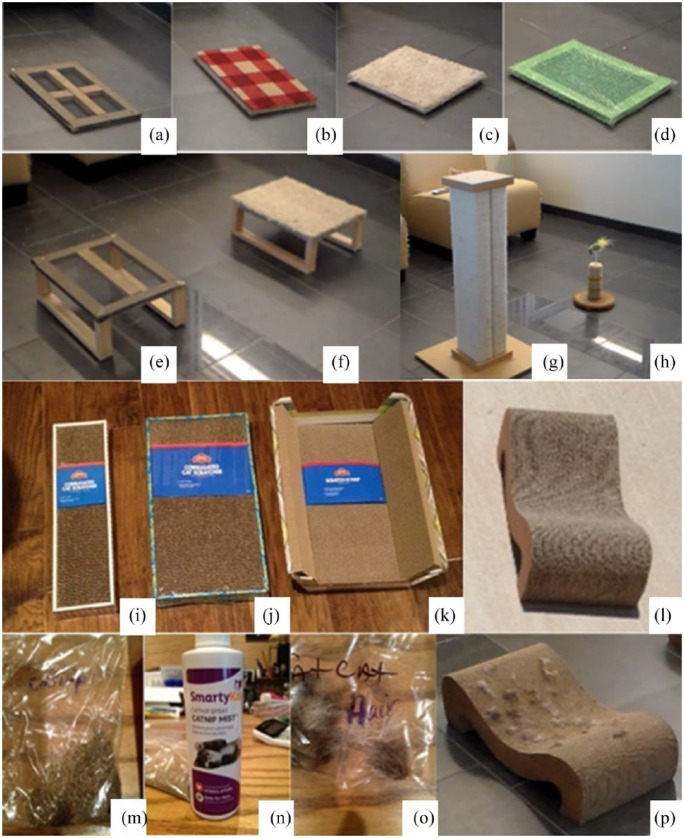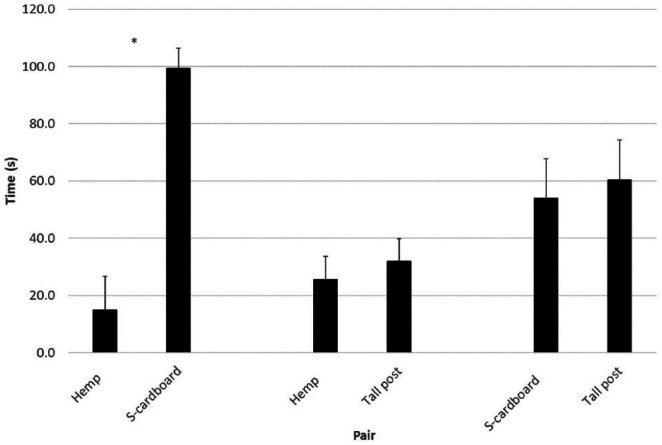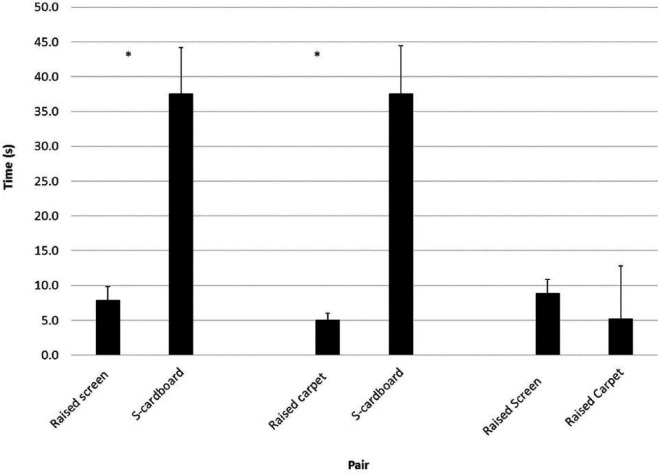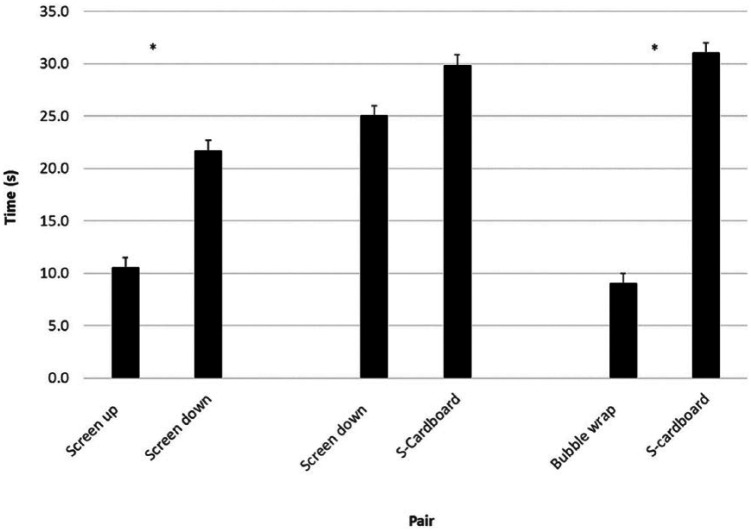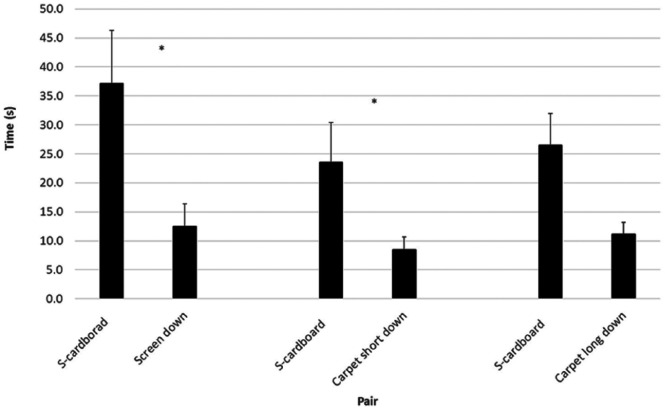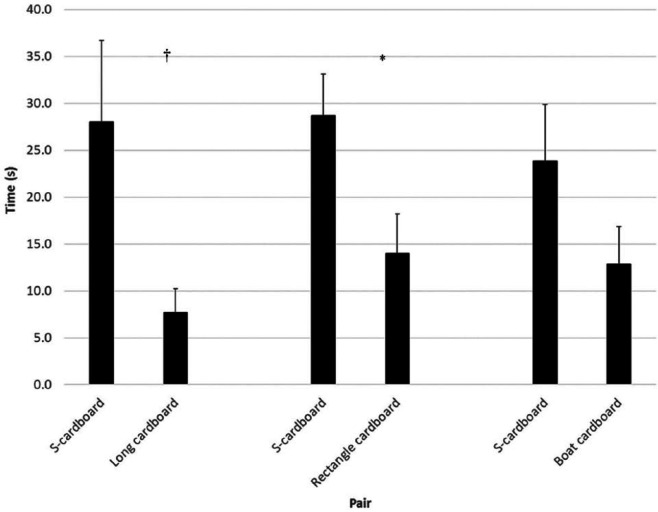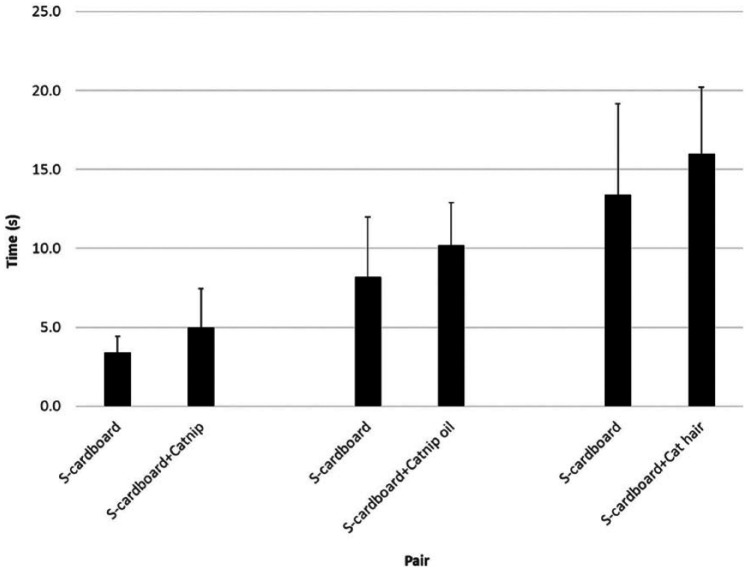Abstract
Objectives
The objective of this study was to determine kitten preferences towards different scratchers and the effects of catnip and cat odor on kitten scratching behaviors.
Methods
Two-choice preference tests were conducted to compare scratchers and preferred scratchers with or without additives (ie, catnip, catnip oil, cat hair) in six studies. Kittens (n = 40, <8 weeks old) had access to two scratchers on the floor of a simulated living room for 20 mins and interactions were video-recorded. The time each kitten spent scratching each scratcher was compared.
Results
In study 1, the S-shaped cardboard was preferred over a hemp post with a toy on top, and no difference was observed in the other pairs of scratchers compared. In study 2, the S-shaped cardboard was preferred by kittens compared with a raised scratcher covered with window screen or with carpet, and no differences were observed between the latter two scratchers. In study 3, the scratcher covered with window screen set upright was preferred over the same scratcher laid horizontally on the floor. The S-shaped cardboard was preferred over the scratcher covered with bubble wrap. In study 4, kittens preferred the S-shaped cardboard over the scratchers covered with window screen or short-fiber carpet but not over the scratcher covered with long-fiber carpet. In study 5, the S-shaped cardboard was strongly preferred over the long cardboard and rectangular cardboard but not over the boat-shaped cardboard. In study 6, dried catnip plant, catnip oil spray or the hair from other cats did not alter the scratching behavior exhibited by the kittens vs the control S-shaped cardboard alone.
Conclusions and relevance
The S-shaped cardboard scratcher was a preferred scratcher for kittens. Catnip or odor of other cats did not alter this behavior in kittens. S-shaped cardboard may be a preferred scratching device for kittens.
Keywords: Scratcher, kitten, scratching behavior, problematic behavior
Introduction
Scratching behavior is a normal expression within the repertoire of cat behaviors, which may serve to sharpen or remove nails, leave visual and olfactory marking, or is a part of stretching or exercising the body.1–3 With more cats being kept indoors, scratching of inappropriate objects within the house may become an increasing problem for owners.1,4 Even though scratching behavior is mainly reported to veterinarians together with other, stress-related behaviors (eg, inappropriate marking), 4 scratching of inappropriate items was shown in 83.0% of the cats (n = 116) presented at a small animal practice that have routine indoor confinement. 5 Most cats have a designated scratching item, but often they still use carpet or furniture covered with fabric. 5 One effective way of reducing this behavior is to place a scratching post near the designated scratching item. 4 Efforts have been made to transfer the scratching behavior onto provided scratchers or posts to reduce the destruction of other items in the house by investigating preferred scratching items. One owner survey found that cats appear to use the scratching post when it is presented in their living area; in addition, they found that cats prefer scratching posts over scratching pads. 5 A separate internet-based study comparing different scratching substrates found that rope was most frequently used when offered vs cardboard, carpet and wood; simple upright posts of at least 3 feet high, or narrower posts (base width ⩽3 feet) were also preferred. 6 These studies indicate that cats appear to prefer certain types of scratchers. We have not, however, found a systematic evaluation of cat scratchers in a controlled setting in the literature.
Natural semiochemicals may influence play and scratching in dogs and cats. One study showed that scratching posts with feline interdigital semiochemical (FIS) were scratched for longer and more frequently by cats than posts without FIS. 7 As punishment does not seem to effectively reduce inappropriate scratching, 5 an alternative, more ethical, option is to redirect the behavior to a designated scratcher that is preferred and/or appealing to cats. For the prevention or reduction of scratching inappropriate items in adult cats, it is of great importance to train them to use scratchers at a young age.The current study compared in kittens (<2 months old) any preference for different types/styles of scratchers and evaluated the effectiveness of catnip and odor from another cat in inducing scratching behavior. Our primary goal was to establish a model to test scratching in kittens. Kittens were chosen as test subjects because they are more playful than adults, which may make this model more sensitive.
Materials and methods
All research was conducted at the local animal shelter with help from personnel not from Texas Tech University, and animals used were from the shelter. Approval of the protocol by the Texas Tech University Institutional Animal Care and Use Committee was not required. However, all procedures were consistent with the US Animal Welfare Act.
Animals and scratchers
Forty neutered kittens (8 weeks old, mixed breed) of both sexes from the Lubbock Animal Service adoption center were used in this study. All kittens had received a veterinary examination and treatment, if needed, before these studies. Test kittens were sufficiently healthy for adoption.
Scratchers covered with window screen, long- or short-fiber carpet (12 mm vs 5 mm), or bubble wrap were manually manipulated into the same size (37.5 cm × 29.5 cm × 3 cm; Figure 1a–d); a wooden holder was used when they were in an upright position. Raised scratchers covered with window screen or long-fiber carpet were made the same size as the other scratchers but with a height of 12 cm (Figure 1e,f). The tall post had a square base measuring 40.5 cm in diameter and a square column post measured 77.5 cm in height and 30 cm in width (Figure 1g). The hemp post that had a mouse toy on top had a base that measured 25 cm in diameter and a round column post that was 10 cm in width and 30 cm in height (Figure 1h). The measurements for the cardboard scratchers were 45.5 cm × 12.5 cm × 5 cm for the long cardboard, 45.5 cm × 24 cm × 5 cm for the rectangular cardboard, 44.5 cm × 35.5 cm × 12 cm for the boat cardboard and 47 × 24 cm × 12 cm for the S-shaped cardboard (Figure 1i–l). The dried catnip plant (Whisker City; Figure 1m), cardboard scratchers, hemp post and the tall post were purchased from Petsmart (www.petsmart.com). The catnip mist spray contained 0.15% catnip oil (Smarty Kat; Figure 1n). The cat hair was collected freshly from adult female cats and sealed in a bag (Figure 1o).
Figure 1.
(a) Scratcher covered with window screen. (b) Scratcher covered with short-fiber carpet. (c) Scratcher covered with long-fiber carpet. (d) Scratcher covered with bubble wrap. (e) Raised scratcher covered with window screen. (f) Raised scratcher covered with long-fiber carpet. (g) Tall post and (h) hemp post with mouse on top. (i–l) Cardboard scratchers: (i) long, (j) rectangular, (k) boat and (l) S-shaped. The (m) dried catnip plant or leaves, (n) catnip oil spray and (o) cat hair used. (p) The cat hair, evenly distributed on the S-shaped cardboard
Experimental design
The experimental room was a space on site that allowed visitors to interact with cats or kittens. The room resembled a living room and measured 4.39 m × 3.63 m. The room had two chairs, a table and a bookcase. The two scratchers and the camera video-taping the scratchers were placed on the floor in the empty space in the room and the locations of the two scratchers were randomly switched (left or right side of the room) for each test. Kittens were introduced to the experimental room one at a time and they were given 20 mins to interact with the scratchers. During the first 10 mins of the test, each kitten was introduced to each scratcher in turn by the researcher so that the kitten was aware of the scratchers in the room. Each kitten was placed on one scratcher and after it was finished with the first scratcher (ie, scratched the scratcher or ignored it), it was then placed on the other scratcher and this process repeated for the first 10 mins. After 10 mins, each kitten could interact freely with the two scratchers at will until the 20 min interaction time was completed. Six studies evaluated different scratchers. Different kittens were used for each study. Studies 1–5 used six kittens for each comparison within the study and study 6 used five kittens. The total number of animals used for each study was eight for study 1, nine for study 3, six for studies 2, 4 and 5, and five for study 6. A variable number of kittens was available over time, based on the shelter’s intake.
Scratchers and scratcher add-on items are shown in Figure 1. Some scratchers were purchased locally and others were handmade for the study. No convention was used to name the scratchers. The names (eg, hemp post) are descriptive.
Study 1 evaluated the hemp post with a mouse-shaped toy on top, the S-shaped cardboard and the tall post. Study 2 included raised scratchers covered with window screen or long-fiber carpet and S-shaped cardboard. All pairs of the three scratchers in studies 1 and 2 were compared.
Study 3 included scratchers covered with window screen set standing up or laid down on the floor, a scratcher with bubble wrap and S-shaped cardboard. For the first pair of comparisons, two randomly selected scratchers were compared. After the two scratchers were compared, the preferred one from the previous test was tested against another scratcher in the next evaluation. Three pairs of comparisons were also conducted in study 3 with four scratchers. The process was the same for studies 4 and 5.
Study 4 included S-shaped cardboard, and scratchers set laid down covered with window screen or with long- or short-fiber carpet. Study 5 included S-shaped cardboard, long cardboard, rectangular cardboard and boat-shaped cardboard.
Study 6 compared the S-shaped cardboard alone (control) with S-shaped cardboard treated with dried catnip plant (leaves and flowers), catnip oil mist spray or cat hair; the dried catnip plant and leaves (5 g), catnip mist spray (for 10 s) and cat hair (5 g) were applied evenly onto the S-shaped cardboard (Figure 1p).
The scratching behavior was recorded as duration of scratcher interaction time (s). Videos were watched by trained personnel.
Statistical analysis
The individual kitten was the experimental and the observational unit. These behavior data were not normally distributed. Non-parametric analyses were therefore deployed. The time the kittens spent scratching each scratcher within each pair was analyzed using the Wilcoxon signed rank test and any difference detected by the test was indicative of one scratcher being preferred over the other one within the same pair. Data are presented as least square mean ± SE for the time in seconds (s) kittens spent scratching each scratcher.
Results
Study 1
Of the hemp post, the S-shaped cardboard and the tall post, only the S-shaped cardboard was preferred by the kittens over the hemp post (99.33 ± 7.06 vs 14.92 ± 11.85; n = 6, s = 10.5 [P = 0.03]; Figure 2); there was no preference between the hemp post and the tall post (25.50 ± 8.09 vs 31.83 ± 7.99; n = 6, s = 2.5 [P = 0.69]; Figure 2), and between the S-shaped cardboard and the tall post (53.83 ± 13.94 vs 60.33 ± 13.97; n = 6, s = 0.5 [P = 1.00]; Figure 2).
Figure 2.
Least square means ± SE for the time in seconds kittens (n = 6) spent scratching each scratcher when hemp post (hemp) and S-shaped cardboard (S-cardboard), hemp and tall post, and S-cardboard and tall post were compared. *P <0.05 according to the Wilcoxon signed rank test
Study 2
The S-shaped cardboard was preferred when compared with either a raised scratcher with covered window screen (37.50 ± 6.68 vs 7.83 ± 1.99; n = 6, s = 10.3 [P = 0.03]; Figure 3) or with a raised scratcher covered with long-fiber carpet (37.50 ± 6.94 vs 5.00 ± 1.00; n = 6, s = 10.3 [P = 0.03]; Figure 3). There was no difference between raised scratchers covered with window screen and carpet (8.83 ± 2.04 vs 5.17 ± 7.61; n = 6, s = −6 [P = 0.25]; Figure 3).
Figure 3.
Least square means ± SE for the time in seconds kittens (n = 6) spent scratching each scratcher when raised scratcher covered with window screen (raised screen) and S-shaped cardboard (S-cardboard), raised scratcher covered with long-fiber carpet (raised carpet) and S-cardboard, and raised screen and raised carpet were compared. *P <0.05 based on the Wilcoxon signed rank test
Study 3
The scratchers covered with the window screen that was either set standing up or on the floor were compared. The screen scratcher on the floor was preferred over the one standing up (21.67 ± 2.95 vs 10.50 ± 2.77; n = 6, s = 10.5 [P = 0.03]; Figure 4). Next, the scratcher covered with window screen set down was compared with the S-shaped cardboard. Kittens interacted with each scratcher the same amount of time (25.0 ± 7.94 for screen down and 29.83 ± 8.25 for cardboard; n = 6, s = 1.5, [P = 0.84]; Figure 4). Kittens preferred the S-shaped cardboard over the scratcher covered with bubble wrap (31.00 ± 8.78 vs 9.00 ± 4.16; n = 6, s = 10.3 [P = 0.03]; Figure 4).
Figure 4.
Least square means ± SE for the time in seconds kittens (n = 6) spent scratching each scratcher when scratcher covered with window screen laid up (screen up) and laid down (screen down), screen down and S-shaped cardboard (S-cardboard), and scratcher with bubble wrap (bubble wrap) and S-cardboard were compared. *P <0.05 using the Wilcoxon signed rank test
Study 4
The S-shaped cardboard was preferred by kittens over a scratcher covered with window screen laid down on the floor (37.17 ± 9.14 vs 12.50 ± 3.86; n = 6, s = −10.5 [P = 0.03]; Figure 5) or a scratcher covered with short-fiber carpet laid on the floor (23.50 ± 6.93 vs 8.50 ± 2.17; n = 6, s = −10.5 [P = 0.03]; Figure 5). The preference towards the S-shaped cardboard was not statistically significant compared with the scratcher covered with long-fiber carpet laid on the floor but followed the same pattern as the other two comparisons (26.50 ± 5.49 vs 11.17 ± 2.01; n = 6, s = −6.5 [P = 0.125]; Figure 5).
Figure 5.
Least square means ± SE for the time in seconds kittens (n = 6) spent scratching each scratcher when S-shaped cardboard (S-cardboard) and scratcher covered with window screen laid down, S-cardboard and scratcher covered with short-fiber carpet laid down (carpet short down), and S-cardboard and scratcher covered with long-fiber carpet laid down (carpet long down) were compared. *P <0.05 according to the Wilcoxon signed rank test
Study 5
The S-shaped cardboard was preferred by kittens over the long cardboard (28.00 ± 8.70 vs 7.67 ± 2.59; n = 6, s = −10.5 [P = 0.03]; Figure 6) and also tended to be preferred over the rectangular cardboard (28.67 ± 4.46 vs 14.00 ± 4.19; n = 6, s = −6.5 [P = 0.06]; Figure 6). The preference towards the S-shaped cardboard was not significant compared with boat cardboard but followed the same pattern as the other two comparisons (23.83 ± 6.60 vs 12.83 ± 4.01; n = 6, s = −4.5 [P = 0.25]; Figure 6).
Figure 6.
Least square means ± SE for the time in seconds kittens (n = 6) spent scratching each scratcher when different-shaped cardboard scratchers were compared separately. *P <0.10 and †P <0.05 according to the Wilcoxon signed rank test
Study 6
The preference of kittens towards the control S-shaped cardboard without any olfactory stimuli was not changed by adding dried catnip plant (3.40 ± 1.02 vs 5.00 ± 2.43; n = 5, s = 2.5 [P = 0.69]; Figure 7), catnip oil (8.20 ± 3.80 vs 10.20 ± 2.68; n = 5, s = 1 [P = 0.75]; Figure 7) or cat hair (13.40 ± 5.75 vs 16.00 ± 4.22; n= 5, s = 2.5 [P = 0.63]; Figure 7).
Figure 7.
Least square means ± SE for the time in seconds kittens (n = 5) spent scratching each scratcher when control S-shaped cardboard only was compared with S-shaped cardboard plus catnip dried plant, catnip oil spray and cat hair. No statistically significant differences were detected based on the Wilcoxon signed rank test in the present study
Discussion
A consistent preference for S-shaped cardboard over other scratchers was shown in kittens across the first five studies. Our findings were not in agreement with other survey-based studies, which have reported that household cats prefer scratching posts than scratching pads. 5 The S-shaped cardboard and the scratching pads used in the current study were different from basic scratching pads in terms of the shape, structure and texture, which might have affected the preference of kittens. Surveys provide one type of information; however, they primarily include human perception of cats’ use of toys. Surveys may not provide objective evaluation of scratcher efficacy.
In a previous study, cats were suggested to prefer narrower posts or a simple upright type or cat tree that has two or more levels and is at least 3 feet high. 6 Our findings do not agree, in general, with this conclusion. When we used carpet and window screen in both horizontal and vertical positions, the kittens preferred the horizontal position. This is not to say that all substrates are preferred in a horizontal position. Nor can we conclude that kitten and adult cat scratcher interactions are the same. Studies are needed to see if juvenile and adult cats have similar or different toy and scratcher preferences.
The current study did not include a cat tree but did compare a hemp post with a mouse on top and a tall post with a rope surface, both of which were standing scratchers. As shown in study 1, the tall post and S-shaped cardboard were almost equally preferred by kittens; S-shaped cardboard was preferred over the hemp post and no difference was shown between the hemp post and the tall post. In study 3, kittens preferred scratchers covered with window screen set down on the floor over those set standing up. Cats of all ages (except geriatric cats) have been shown to prefer rope; 6 the surface of the standing part of the hemp post and tall post were both made with a rope material and they were not preferred by kittens relative to cardboard scratchers. Scratchers covered with long- or short-fiber carpet were also less preferred or not preferred more than the S-shaped cardboard. Of the different cardboards, the S-shaped cardboard was preferred by kittens over the other shaped cardboard. In conclusion, the S-shaped cardboard was the most preferred over other scratchers in kittens.
The results from study 6 indicated that catnip, in the form of dried plant and leaves or oil spray, was not effective in attracting kittens to the scratcher or in inducing more scratching behavior in kittens. Catnip is a popular plant used by cat owners as a form of enrichment in cats as it elects ‘playful’ behaviors in most feline species. Catnip induces active responses (eg, sniffing, licking, cheek or chin rubbing, playing) in about 50% of the cat population. Responses are affected mostly by age and sex, with small effects attributable to early gonadectomy. 8 These behavioral responses are also found in neutered cats. 9 Responses usually last for about 5–15 mins and catnip is generally believed to be non-addictive. 10 The main responsible molecule identified in catnip is nepetalactone and catnip effects have been shown to be mediated by the olfactory system.11,12 Our results agree with one study, which reported that infant cats (<3 months) rarely display behavioral responses (eg, rolling over) after exposure to catnip. 8 The lack of active responses to catnip in kittens may be explained by immature brain development, especially the opioidergic system. A supportive study found that the effect of nepetalactone in mice was blocked by the opioid antagonist naloxone. 13 Another study reported that endogenous opioids are not fully functional in infant cats <2 months old. 14 Catnip is believed to activate the ventromedial nucleus of the hypothalamus (VMH), the brain area that is involved in regulating many physiological activities. Among these are mate recognition and sexual behavior, even in the absence of gonadal hormones.5,15 The VMH expresses different types of opioid receptors and is part of the multiple reward circuitries, such as sexual reward.16–18 The behavioral responses (eg, rolling over, chin rubbing) in cats following the exposure to catnip are similar to the behaviors expressed by female cats after mating or those induced by an opioid receptor agonist (ie, morphine).19,20 These studies indicate that a likely reason for catnip not being able to induce behavioral responses in kittens is that the kitten opioid receptor system may not be fully developed.
Cat hair did not increase scratching behavior in kittens when applied to the scratchers. The hair was collected from the back and side of the body of neutered cats and might have contained cat odorants and/or semiochemicals. 21 Unfortunately, we did not determine the specific molecules that might exist in the cat hair, and the possible effects of the cat odorants and/or semiochemicals on scratching behavior in kittens cannot be discussed here. Moreover, kittens and adult cats may differ in their perception and responses to different pheromones and biologically active plants and plant extracts. The efficacy of odorants and/or semiochemicals, including different pheromones, in inducing scratching behavior in kittens requires further investigation.
Conclusions
A model of scratcher efficacy is presented. Using this model system, the S-shaped cardboard scratcher was most effective at increasing kitten scratching or interacting. The common olfactory/gustatory stimuli did not increase scratcher interaction in kittens.
Acknowledgments
We thank the Lubbock Animal Service for offering the kittens and experimental room for the study. We thank Dr Arlene Garcia for reviewing this manuscript prior to submission.
Footnotes
Accepted: 19 July 2018
The authors declared no potential conflicts of interest with respect to the research, authorship, and/or publication of this article.
Funding: The authors received no financial support for the research, authorship, and/or publication of this article.
ORCID iD: Lingna Zhang  https://orcid.org/0000-0003-0657-9431
https://orcid.org/0000-0003-0657-9431
Rebekkah Plummer  https://orcid.org/0000-0003-0293-693X
https://orcid.org/0000-0003-0293-693X
References
- 1. Landsberg G. Feline behavior and welfare. J Am Vet Med Assoc 1996; 208: 502–504. [PubMed] [Google Scholar]
- 2. Hart BL. Behavioral aspects of scratching in cats. Feline Pract 1972; 2: 6–8. [Google Scholar]
- 3. Heath SE. Behaviour problems and welfare. In: Rochlitz I. (ed). The welfare of cats. Amsterdam: Springer, 2007, pp 91–118. [Google Scholar]
- 4. Mengoli M, Mariti C, Cozzi A, et al. Scratching behaviour and its features: a questionnaire-based study in an Italian sample of domestic cats. J Feline Med Surg 2013; 15: 886–892. [DOI] [PMC free article] [PubMed] [Google Scholar]
- 5. Moesta A, Keys D, Crowell-Davis S. Survey of cat owners on features and preventative measures of feline scratching of inappropriate objects: a pilot study. J Feline Med Surg 2018: 20; 891–898. [DOI] [PMC free article] [PubMed] [Google Scholar]
- 6. Wilson C, Bain M, DePorter T, et al. Owner observations regarding cat scratching behavior: an internet-based survey. J Feline Med Surg 2016; 18: 791–797. [DOI] [PMC free article] [PubMed] [Google Scholar]
- 7. Cozzi A, Lecuelle CL, Monneret P, et al. Induction of scratching behaviour in cats: efficacy of synthetic feline interdigital semiochemical. J Feline Med Surg 2013; 15: 872–878. [DOI] [PMC free article] [PubMed] [Google Scholar]
- 8. Espín-Iturbe LT, Yañez BAL, García AC, et al. Active and passive responses to catnip (Nepeta cataria) are affected by age, sex and early gonadectomy in male and female cats. Behav Processes 2017; 142: 110–115. [DOI] [PubMed] [Google Scholar]
- 9. Todd NB. Inheritance of the catnip response in domestic cats. J Hered 1962; 53: 54–56. [DOI] [PubMed] [Google Scholar]
- 10. Tucker AO, Tucker SS. Catnip and the catnip response. Econ Bot 1988; 42: 214–231. [Google Scholar]
- 11. Hart BL, Leedy MG. Analysis of the catnip reaction: mediation by olfactory system, not vomeronasal organ. Behav Neural Biol 1985; 44: 38–46. [DOI] [PubMed] [Google Scholar]
- 12. Bol S, Caspers J, Buckingham L, et al. Responsiveness of cats (Felidae) to silver vine (Actinidia polygama), Tatarian honeysuckle (Lonicera tatarica), valerian (Valeriana officinalis) and catnip (Nepeta cataria). BMC Vet Res 2017; 13: 70. [DOI] [PMC free article] [PubMed] [Google Scholar]
- 13. Aydin S, Beis R, Özturk Y, et al. Nepetalactone: a new opioid analgesic from Nepeta caesarea Boiss. J Pharm Pharmacol 1998; 50: 813–817. [DOI] [PubMed] [Google Scholar]
- 14. Thor KB, Blais DP, Kawatani M, et al. Postnatal development of opioid regulation of micturition in the kitten. Dev Brain Res 1990; 57: 255–261. [DOI] [PubMed] [Google Scholar]
- 15. Georgescu M, Sabongui C, Del Corpo A, et al. Vaginocervical stimulation induces Fos in glutamate neurons in the ventromedial hypothalamus: attenuation by estrogen and progesterone. Horm Behav 2009; 56: 450–456. [DOI] [PubMed] [Google Scholar]
- 16. Acosta-Martinez M, Etgen AM. Activation of μ-opioid receptors inhibits lordosis behavior in estrogen and progesterone-primed female rats. Horm Behav 2002; 41: 88–100. [DOI] [PubMed] [Google Scholar]
- 17. Acosta-Martinez M, Etgen AM. The role of δ-opioid receptors in estrogen facilitation of lordosis behavior. Behav Brain Res 2002; 136: 93–102. [DOI] [PubMed] [Google Scholar]
- 18. García-Horsman SP, Ǻgmo A, Paredes RG. Infusions of naloxone into the medial preoptic area, ventromedial nucleus of the hypothalamus, and amygdala block conditioned place preference induced by paced mating behavior. Horm Behav 2008; 54: 709–716. [DOI] [PubMed] [Google Scholar]
- 19. Palen GF, Goddard GV. Catnip and oestrous behaviour in the cat. Anim Behav 1966; 14: 372–377. [DOI] [PubMed] [Google Scholar]
- 20. Villablanca JR, Harris CM, Burgess JW, et al. Reassessing morphine effects in cats: I. Specific behavioral responses in intact and unilaterally brain-lesioned animals. Pharmacol Biochem Behav 1984; 21: 913–921. [DOI] [PubMed] [Google Scholar]
- 21. Pageat P, Gaultier E. Current research in canine and feline pheromones. Vet Clin North Am Small Anim Pract 2003; 33: 187–211. [DOI] [PubMed] [Google Scholar]



